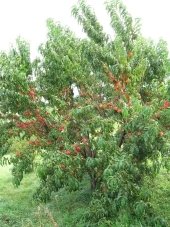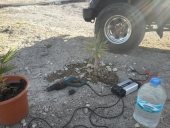


going off topic again but now my question is on the Fukuoka method of broadcasting seeds onto the cover crop. All these cover crop seems to have anti weed property, I think because they crowd area out before weed can take hold. So my thing with grass is that they grow so tightly that if you were to broadcast say for example tomato seeds onto grass, I'm not sure if tomatoes will ever be able to grow through the thick patch of grass. At least this is my current experiences with all the lawns I've seen. The soil underneath is tightly knit by the grass roots so it becomes hard. However clover don't seem to do this from my observation. They don't grow as tight as lawn and there are crevices in between where clovers grow and soil is soft. when seeds are broadcasted seeds can find a niche to grow in. My question is how to grow via seed balls methods when all these cover crop have "crowd out every other plant thus anti weed property"? And I'm thinking that clovers not being as anti weedy as grass is a better balance to have living mulch and to still be able to broadcast seeds onto.Bryant RedHawk wrote:hau Samuel, cover crops do far better when grown as a mix.
Why would someone want to monocrop a cover crop?
I use a blend of something around 20 different plant species for covers, four of them are clovers, buckwheat, alfalfa, cereal rye, fescue, annual rye, rape, seven top turnip and on and on.
The reason for this is to get variety and thus diversity along with the many different root growth patterns, bacteria diversity, fungal diversity, the more different plants that are used, the better the end result soil will be.
Redhawk


. What's grass for when cover cropping? It says weed control but don't they all weed control? Do grass fix nitrogen like clover does? Or does nitrogen fixing even matter if grass has so much nutrients (think wheatgrass, has all mineral and nutrients known possible). My question is why would I ever include grass in my mix of cover crop when clover seems to offer me more benefits? Or do cover crop grow better when mixed up?Gurkan Yeniceri wrote:I have converted the table 4.11 in Fukuoka-San's book "The Natural Way of Farming" into an Excel sheet and took a screen shot.
enjoy

ocean view is generally windy. Hawaii is the island of extremes. We have 10 of the 14 climate zones. North you have lush green, rainy and humid. South you have barren land, dry air, little rain compared to downtown. People don't like ocean view since there is local superstition of the land being cursed. It's right next to the largest volcano after all. Lots of underground acitivity. If you go way over to South point, the trees are all bent. People living there report 90 mph wind. Seems dependent on the elevation though my site doesn't seem to be that bad. Rainwater here just sinks as there is no soil to hold moisture. Not sure if rivulets even form here. I don't think I've ever seen a river or traces of river here. Land is otherworldly here. It's like Mars, maybe even hell. Yeah I've been working on observing the natural vegetation here. Lots of dead ohia rainforests here. Small stunted weed like plant and shrubs growing here and there in crevices of rocks. I wish I had a convenient app that could identify these wild plants for me.Joseph Lofthouse wrote:I have been feeling uneasy about the crazy winds mentioned in the title of this thread, and the ongoing comments about mitigating winds. When I closely examine photos of the trees in Ocean View, I don't see much evidence that wind is particularly troubling to them. They tend to be growing approximately vertical.
A recent comment about "dry air" was particularly jarring to me... This is Hawaii that we are talking about, where it is humid to muggy more than 85% of the time... Seems to me, like the winds should be welcomed into the garden in celebration of the humidity and mugginess that they bring with them, not excluded by fears of drying stuff out. I have never built an air-well, they won't work here, but it seems like they would thrive on being exposed to wind.
Manually moving bedrock is back-breakingly slow work. A person might work all week, and only have moved enough rock set a kitchen chair into the pit. Moving bedrock with equipment isn't much quicker...
My experience is that it is the small things that are the most effective at terraforming:
Going out during a rainstorm, to watch where the water runs, and putting a pebble or twig into a rivulet to slow the flow a little bit...
Doing that during 1000 rainstorms could accomplish a tremendous amount of terraforming.
Visiting on a foggy day to pay attention to which species of plants collect the most mist, and planting more of them.
Going out first thing in the morning to measure which rock configurations are collecting the most dew.
There have been a few posts in this thread by those who are living/working in Hawaii. They strike me as the most valuable: Local advice for local problems.

Any updates on how the trees are doing?Steve Farmer wrote:Grab your potted tree and find a spot with another tree nearby so it won't get lonely.
£90 chinese inverter from ebay UK and 40 euro cheap Lidl hammer drill. Spend some money on quality tools if you like but this stuff has lasted me years in the heat and dust. The 25 yr old Land Cruiser... now that IS quality

. I'm not living there at the moment. I'll start this project in January so I'm just brainstorming at the moment. step 1 make a gigantic rock berm for instant windbreak.Jo Hunter-Adams wrote:Are you living on site? If not, I would suggest starting by just piling up all free sources of biomass.
Before adding trees as windbreaks, I would trial a few (keeping them in bags) for a week or two in the place you want to plant, to acclimate them and see how they do. Piles of biomass can also act as a windbreak for the windbreak, if you're not living on site? I.e. pile biomass high, planting in behind it. You can always move the biomass once the windbreak is established. If there's anything that you can free seeds/cuttings for (e.g. pineapple heads from restaurants), I would consider trying those in bags to start, then transplanting out.
If there's nothing really growing, I wouldn't worry too much about whether something is edible to start with-- If you find you're getting plants (cheap, hardy plants!) growing it'll be easy to chop and drop (and make more piles of biomass). For year one biomass and any types of cheap/free plants at all would seem a good experiment.

Joseph Lofthouse wrote:
Samuel Kuo wrote:How long will it take for lichen and wind erosion to erode rock to soil?
Takes a very long time to erode rock... However, even without erosion, lichen is a living thing. It dies and creates soil.
Samuel Kuo wrote:I realize that this works with natural succession but can't we simply speed up succession by importing soil which is what the land wants? What are the negative consequences of doing this? Or what if we just have a machine that manually breaks the rocks into sand and add organic matter to it to create soil?
You haven't commented about the budget for this project. Most of the suggestions you received were low cost activities that you can do with minimal labor and finances. Things which will allow the local ecosystem to create conditions to support a richer local ecosystem. Last time I calculated the cost of adding 4 inches of compost to my 2 acre field, it was more than the cost of the land: Enough to have built a decent house. And was approximately the total inventory of my county's compost manufacturing capabilities. If I am importing compost onto a piece of land, I am desertifying the areas where the compost came from.

